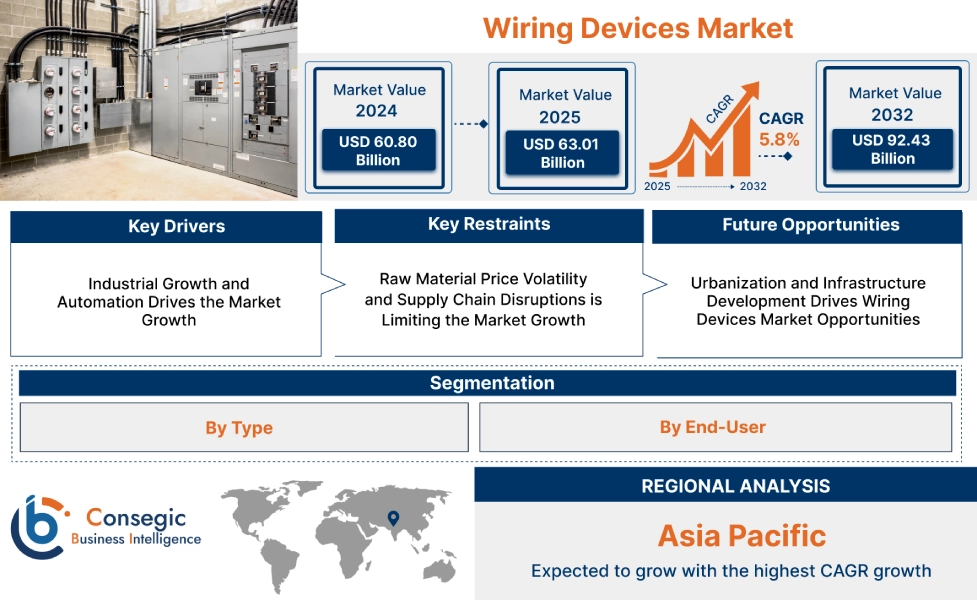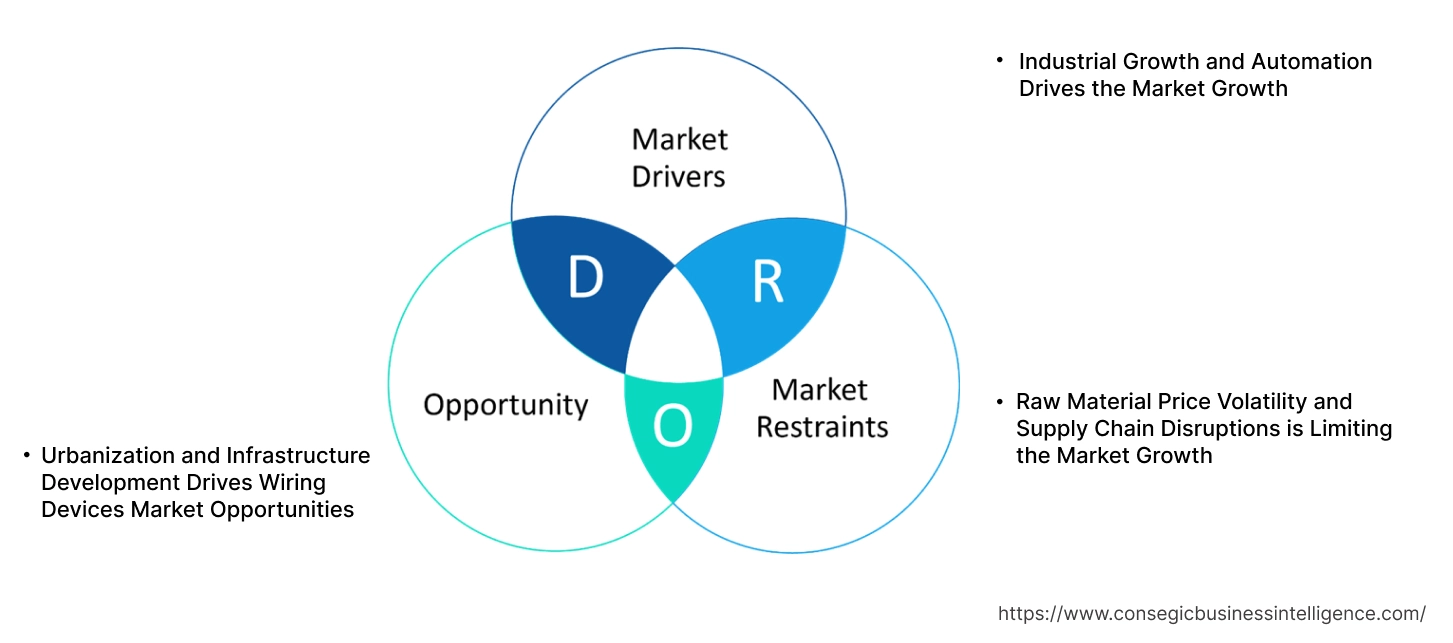Wiring Devices Market Size:
Wiring Devices Market is estimated to reach over USD 92.43 Billion by 2032 from a value of USD 60.80 Billion in 2024 and is projected to grow by USD 63.01 Billion in 2025, growing at a CAGR of 5.8% from 2025 to 2032.
Wiring Devices Market Scope & Overview:
Wiring devices are essential electrical components that serve as connection or control points within an electrical circuit. They facilitate the safe and efficient distribution of power to various appliances, lighting fixtures, and other electrical equipment. The different types of wiring solutions include receptacle, switches, circuit breakers, fuses, connectors, insulators, junction boxes, cable organizers, and others. Further, accelerating adoption of smart home technologies and IoT integration is leading to the need for connected switches, outlets, and dimmers that offer automation and energy monitoring. Furthermore, increasing global emphasis on energy efficiency regulations and sustainability is pushing for wiring devices that optimize power consumption, support renewable energy integration, and utilize eco-friendly materials.
How is AI Transforming the Wiring Devices Market?
AI is reshaping the wiring devices market by driving innovation in efficiency, safety, and automation. Conventional switches, outlets, and connectors are now evolving into intelligent, AI-powered systems that adapt to user behavior. These devices can optimize power usage, manage lighting and appliances, and contribute to overall energy savings. AI also plays a vital role in safety by identifying irregular loads, detecting faults, and preventing fire risks through real-time monitoring. In industrial and commercial applications, AI-enabled wiring devices support predictive maintenance, ensuring smooth operations and reduced downtime. As smart homes and smart buildings continue to expand, AI is turning wiring devices into key components of connected, intelligent infrastructures worldwide.
Wiring Devices Market Dynamics - (DRO) :
Key Drivers:
Industrial Growth and Automation Drives the Market Growth
Industry growth fuels the wiring device market growth by demanding vast electrical infrastructure for new factories, production lines, and facility modernizations. This includes everything from basic switches and outlets to complex power distribution and safety systems, especially in hazardous environments. Further, automation propels the requirement by increasing the complexity and intelligence of industrial electrical networks. Furthermore, the integration of IoT, AI, and robotics requires advanced wiring devices for high-speed data transmission, precise control, and smart monitoring. This drives demand for robust, reliable, and connected solutions that ensure operational efficiency and safety in automated industry.
- For instance, in December 2023, Mitsubishi Electric India introduced its new smart manufacturing facility for advanced factory automation systems in the state of Maharashtra, India. The new manufacturing facility is optimized to deliver products with highest quality and reliability while strengthening its business in India and addressing the increasing demand for advanced automation and smart manufacturing solutions.
Thus, increasing trends of automation and industrial expansion contribute significantly to the wiring devices market size.
Key Restraints:
Raw Material Price Volatility and Supply Chain Disruptions is Limiting the Market Growth
The wiring devices market faces significant limitations due to raw material price volatility and supply chain disruptions. Raw materials including copper, aluminum, and various plastics are essential components, and their prices are highly susceptible to global economic shifts, geopolitical events, and demand fluctuations. Further, sudden price spikes directly increase manufacturing costs, eroding profit margins for wiring device producers. This uncertainty creates long-term pricing and strategic planning challenges. Furthermore, supply chain disruptions caused by natural disasters, geopolitical conflicts, transportation bottlenecks, or labor shortages can halt the flow of these critical materials. Thus, raw material price volatility and supply chain disruptions limits the market growth.
Future Opportunities :
Urbanization and Infrastructure Development Drives Wiring Devices Market Opportunities
The growing urbanization with increasing populations migrating to cities, creates a fundamental demand for new residential, commercial, and industrial construction. Every new building requires extensive electrical wiring systems, from basic switches and outlets to complex circuit protection devices, directly boosting the wiring devices market. Additionally, massive infrastructure development projects including smart cities , transportation networks, and upgraded power grids further accelerate the market. Moreover, these projects necessitate advanced, energy-efficient, and often smart wiring devices to support interconnected systems, renewable energy integration, and electric vehicle charging infrastructure.
- For instance, according to the Building and Construction Authority of Singapore, the total construction demand including residential and commercial construction in Singapore is expected to reach between USD 24 billion to USD 29 billion by the end of 2024. The growth in construction buildings is expected to drive the market.
Thus, urbanization and infrastructure development driven by increasing population drives the wiring devices market opportunities.
Wiring Devices Market Segmental Analysis :
By Type:
Based on the type, the market is segmented into current carrying and non-current carrying.
Trends in the Type:
- Trends including easy installation, expansion, and maintenance of modular cable trays, raceways, and clips drive the wiring devices market trends.
- Increasing focus on using recycled plastics and bio-based materials to minimize environmental impact in turn drives the wiring devices market size.
Current carrying accounted for the largest revenue share in the year 2024 and is anticipated to register the fastest CAGR during the forecast period.
- Increasing trend of adoption of arc fault circuit interrupters and ground fault circuit interrupters is driving the wiring devices market share.
- Further, as energy costs rise and environmental concerns grow, there's a strong push for devices that help reduce electricity consumption.
- Furthermore, there's a growing emphasis on the aesthetics of current-carrying devices which in turn drives the wiring devices market trends.
- Thus, as per wiring devices market analysis, increased need for energy efficiency, enhanced safety, and aesthetic appeal in print quality are driving the market.
By End-User:
Based on the end user, the market is segmented into residential, commercial, and industrial.
Trends in the End User:
- Wiring devices are becoming integral components of IIoT ecosystems in smart factories which in turn drives the wiring devices market share.
- Growing need for heavy-duty, impact-resistant, dustproof, and waterproof wiring devices, plugs, and receptacles in industries drives the wiring devices market expansion.
Residential accounted for the largest revenue share of 54.20% in the year 2024.
- Consumers are increasingly integrating smart switches, dimmers, outlets, and smart plugs for enhanced convenience, energy management, and security in turn driving the wiring devices market growth.
- Further, features like voice control, remote access via apps, and integration with broader smart home ecosystems significantly boost the market.
- Furthermore, aesthetics, customizable designs, and emphasis on energy efficiency also play a key role in driving the market.
- For instance, Schneider Electric offers X Series wiring devices which are a contemporary line of residential electrical fittings that blend simple installation with sleek aesthetics and smart home capabilities. These devices feature interchangeable flush-facing covers and a variety of designer colors, allowing for customization to match any interior.
- Thus, as per wiring devices market analysis, smart device integration, energy efficiency, and aesthetics are driving the market.
Commercial is anticipated to register the fastest CAGR during the forecast period.
- Factors including advanced circuit protection, emergency lighting controls, and integrated fire safety systems drive the wiring devices market growth.
- Further, trends including the adoption of smart dimmers, occupancy sensors, energy-efficient outlets, and power monitoring solutions in turn propels the wiring devices market expansion.
- Furthermore, increasing requirements for modular wiring systems, raised floor boxes, and flexible conduits drive the market.
- Therefore, based on analysis, security integration, focus on energy management, and modular and flexible wiring solutions are anticipated to boost the wiring devices market demand.
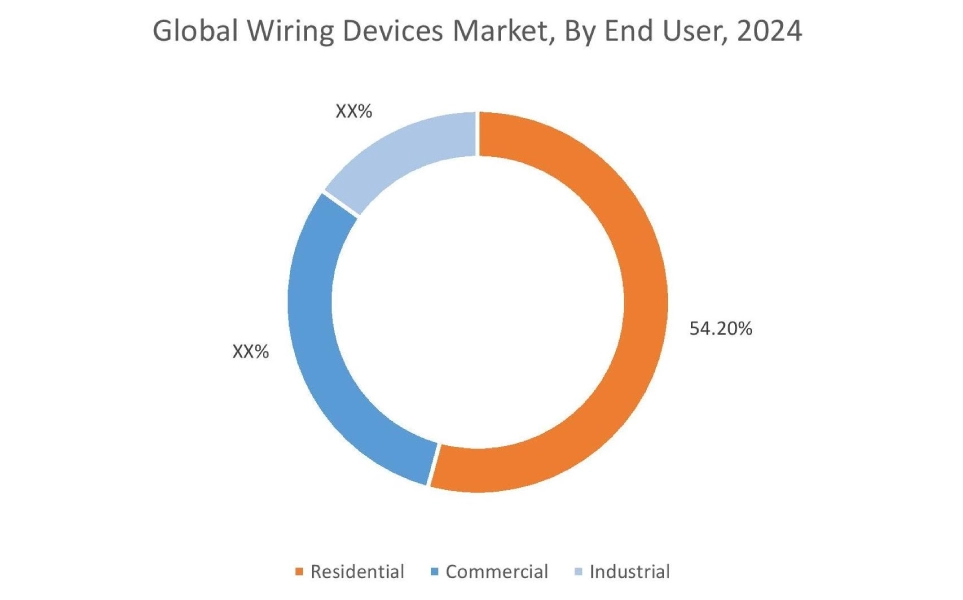
Regional Analysis:
The regions covered are North America, Europe, Asia Pacific, Middle East and Africa, and Latin America.
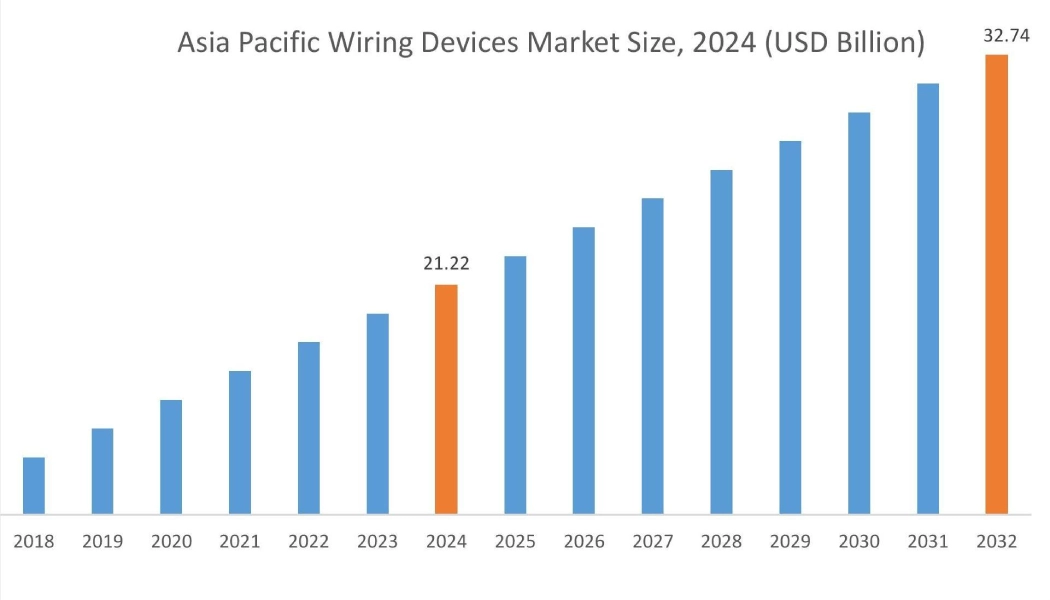
Asia Pacific region was valued at USD 21.22 Billion in 2024. Moreover, it is projected to grow by USD 22.02 Billion in 2025 and reach over USD 32.74 Billion by 2032. Out of this, China accounted for the maximum revenue share of 31.10%. As per analysis, the market is mainly driven by rapid urbanization, extensive infrastructure development, and the burgeoning adoption of smart home technologies.
- For instance, in March 2023, Honeywell launched Blenze Pro, a new premium line of wiring solutions tailored for the Indian market. The devices are designed for high-end residential, commercial, and hospitality projects. Further, Blenze Pro offers a sophisticated aesthetic with front plates made of metal and glass, along with silent, soft-touch operation.
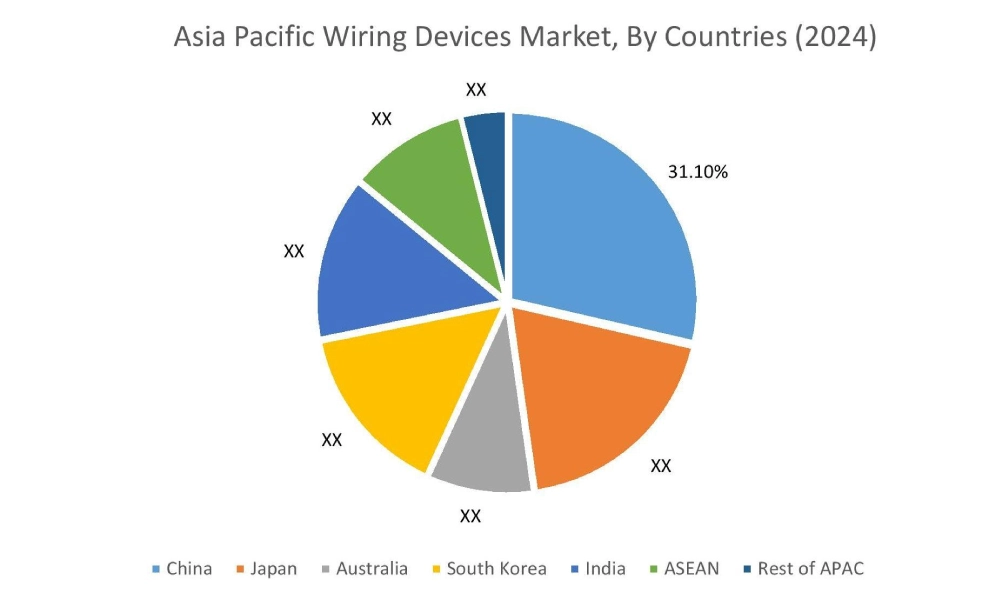
North America is estimated to reach over USD 26.20 Billion by 2032 from a value of USD 17.16 Billion in 2024 and is projected to grow by USD 17.79 Billion in 2025. The North American market is primarily driven by robust smart home and building automation adoption, extensive renovation and retrofitting activities in existing infrastructure, and stringent energy efficiency regulations.
- For instance, on November 2022, in Boston, MA, USA, Schneider Electric announced that its new Square D X Series Connected Wiring Solutions received a Good Housekeeping 2022 Home Renovation Award in the 'Brightest Electric Ideas' category. This innovative line of residential electrical devices was recognized for its ability to provide homeowners with transparent, plug-level energy usage data.
The regional analysis depicts stringent energy efficiency regulations, ambitious decarbonization targets for buildings, and a strong emphasis on smart homes in Europe is driving the market. Additionally, the factor driving the market in the Middle East and African region are significant investments in infrastructure development especially in the construction and power generation industry. Further, based on analysis, infrastructure development urbanization and industrialization across the region are paving the way for the progress of wiring devices market demand in the Latin America region.
Top Key Players & Market Share Insights:
The global wiring devices market is highly competitive with major players providing solutions to the national and international markets. Key players are adopting several strategies in research and development (R&D), product innovation, and end-user launches to hold a strong position in the wiring devices industry. Key players in the global wiring devices market include-
- Schneider Electric SE (France)
- ABB Ltd. (Switzerland)
- Hubbell Inc. (US)
- KEI (India)
- TE Connectivity (Japan)
- FURUKAWA ELECTRIC CO., LTD. (Japan)
- Legrand S.A. (France)
- Eaton Corporation plc (Ireland)
- Leviton Manufacturing Co., Inc (US)
- Honeywell International Inc. (US)
- Panasonic Corporation (Japan)
Recent Industry Developments :
Product Launch
- In August 2024, Schneider Electric launched Miluz Lara, a new range of stylish and functional switches and sockets designed for modern Indian homes and buildings. Further, the device features elegant dew-drop-inspired designs, easy maintenance, and LED indicators, and comes in White and Anthracite colors.
Wiring Devices Market Report Insights :
| Report Attributes | Report Details |
| Study Timeline | 2019-2032 |
| Market Size in 2032 | USD 92.43 Billion |
| CAGR (2025-2032) | 5.8% |
| By Type |
|
| By End-User |
|
| By Region |
|
| Key Players |
|
| North America | U.S. Canada Mexico |
| Europe | U.K. Germany France Spain Italy Russia Benelux Rest of Europe |
| APAC | China South Korea Japan India Australia ASEAN Rest of Asia-Pacific |
| Middle East and Africa | GCC Turkey South Africa Rest of MEA |
| LATAM | Brazil Argentina Chile Rest of LATAM |
| Report Coverage |
|
Key Questions Answered in the Report
How big is the wiring devices market? +
The wiring devices market is estimated to reach over USD 92.43 Billion by 2032 from a value of USD 60.80 Billion in 2024 and is projected to grow by USD 63.01 Billion in 2025, growing at a CAGR of 5.8% from 2025 to 2032.
What specific segmentation details are covered in the wiring devices report? +
The Wiring Devices report includes specific segmentation details for type, end user, and regions.
Which is the fastest segment anticipated to impact the market growth? +
In the wiring devices market, commercial is the fastest-growing segment during the forecast period.
Who are the major players in the wiring devices market? +
The key participants in the wiring devices market are schneider Electric SE (France), ABB Ltd. (Switzerland), Legrand S.A. (France), Eaton Corporation plc (Ireland), Leviton Manufacturing Co., Inc (US), Honeywell International Inc. (US), Panasonic Corporation (Japan), Hubbell Inc. (US), KEI (India), TE Connectivity (Japan), FURUKAWA ELECTRIC CO., LTD. (Japan) and others.
What are the key trends in the wiring devices market? +
The wiring devices market is being shaped by several key trends including rapid urbanization and infrastructure development, increasing adoption of smart home and IoT technologies, growing demand for energy-efficient solutions, and the expansion of industrial automation.
